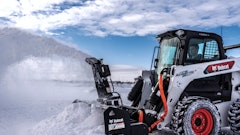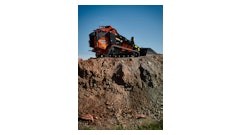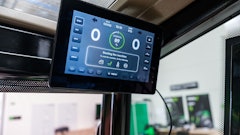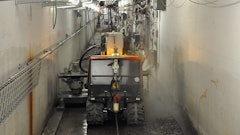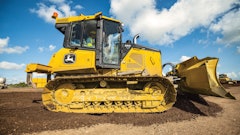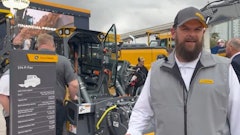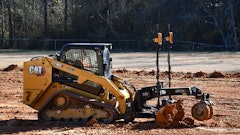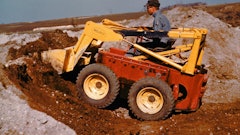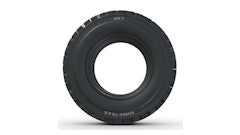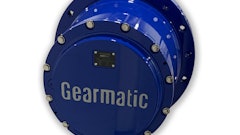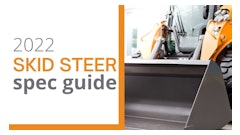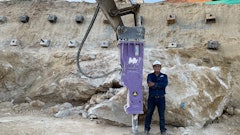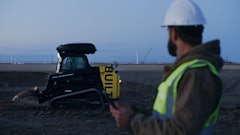Three basic types of control systems are offered on skid-steer loaders: manual controls, servo controls and pilot controls. Manual controls offer a direct linkage to hydraulic lift arm and bucket control valves, as well as the hydrostatic transmission swash plate (which controls machine direction). “Industry wide, manual controls are the dominant skid-steer control system — 60% of the units sold today are equipped with manual controls, followed by 25% with servo controls and 15% with pilot controls,” says Larry Foster, product marketing manager, skid steers, John Deere Construction and Forestry Division.
He notes that larger-frame skid steers tend to dig, push and carry heavier loads. “If a skid steer is equipped with manual controls, the load forces can be transmitted back through the controls to the operator, requiring the operator to apply more force to the controls,” he states.
Control forces can be dramatically reduced through the use of servos or pilot controls. “Our larger three models are all servo machines,” says Foster. He compares servo controls to power steering on an automobile. “Servos provide smooth ‘power steering-like’ control efforts. The servo applies the forces to the transmission, not the operator. The operator experience at the controls is an effortless, smooth feel coupled with precise control.”
NCD Developers annually racks up 5,000 hours on its John Deere skid-steer loaders. This Bristol, RI, development company uses skid steers to perform site prep, utility work and tree relocation. The machines are also used to move patio blocks and building materials. In the last several years, Michael Fonseca, the owner, has witnessed an improvement in operator controls. “They are a lot less effort today than they were back then,” he states. “Naturally, technology and safety have been upgraded.”
Bobcat Co. offers standard manual (mechanical) hydraulic controls, an Advanced Hand Control System (ACS) and Selectable Joystick Controls (SJC). “With ACS, steering is manually controlled by two levers. Lift arm and bucket functions can be changed from foot pedals to hand actuated,” says Mike Fitzgerald, product representative for Bobcat. “It is very popular with operators who have operated multiple brands of equipment and are familiar with either foot pedals or hand controls.”
SJC also allows the operator to choose from two modes of operation. “The SJC-equipped machines use short electric joysticks that allow the operator to utilize his hands and wrists for machine movement, as well as lift arm and bucket functions,” says Fitzgerald. A switch in the machine enables the operator to change the selectable joysticks from ISO-pattern (left joystick controls drive functions, while the right joystick controls lift and tilt functions) to H-pattern (fore and aft movement of each joystick controls left and right drive functions independently, while side-to-side joystick movement controls hydraulic functions).
Finally, some skid steers utilize pilot hydraulic controls. Similar to servo controls, pilot hydraulic controls, such as those used on Caterpillar skid-steer loaders, require minimal effort and provide precise control.
Adapting To The Operator
The ability to change control patterns at the flick of a switch has many benefits for operators who may be familiar with multiple types of machines. “We are trying, from a product standpoint, to offer operators the ability to run a machine in their most learned method of operation,” says Fitzgerald. “That’s why we offer different types and styles of controls. The operator can choose the control system with which he is most familiar.”
Larry Brown Excavating, Liberty, MO, considers SJC an important productivity feature. “If the operator isn’t used to the controls on a machine, he certainly can’t do what he could do if he is on the machine every day,” says Larry Brown. “I don’t want them to have to go from one style of control to another.”
Larry Brown Excavating’s Bobcat T250 and T300 track loaders are equipped with SJC. This allows Brown’s operators to switch the control patterns between H-pattern and ISO-pattern, depending on their preference. Operators familiar with the company’s Caterpillar dozers or Takeuchi loader can jump into the Bobcat loaders and not miss a step. “They are just easier in my opinion,” says Brown.
But the ability to select different control patterns just scratches the surface of electric capabilities. “We have the ability to change the way the machine operates via the electric controls, and allow for smooth operation at slow speeds when people are trying to work in tight, confined areas,” says Fitzgerald.
A snail icon on the left handle slows down the machine. “You still have full joystick movement, but you are operating at 4 mph instead of 7 mph,” says Fitzgerald. “Now your maneuverability is much better in those tight areas.”
“You still have full engine horsepower, but you push that button and it slows your travel speed down and you get more efficient operation,” says Lance Mathern, a Bobcat marketing manager. “It’s also adjustable. You can dial it up or down to be anywhere essentially from 0 to 7 mph. If you are running a planer or a wheel saw — something where you want to go very slow at a very consistent speed — you can set that speed and push the joystick all the way forward.
“You don’t have to be constantly holding that joystick in a specific place,” he continues. “It is almost like cruise control, except you have to hold the joystick forward.”ACS and SJC continue to represent a growing percentage of Bobcat sales due to customer demand.
Complex Control From The Cab
“Precise and accurate control of work tools increases productivity,” notes Chris Key, commercial supervisor, skid-steer loaders and multi-terrain loaders, Caterpillar Inc. “The biggest advancements for in-cab control of work tools are to put more functions in the operators’ hands and give the operators of machines the functionality they want at their fingertips.” The layout of the buttons, triggers and sliders can actually enhance control of the work tool.
Caterpillar’s Deluxe joysticks provide this type of fingertip control, notes Key. “The applications that benefit most are those requiring use of hydro-mechanical work tools, which require more than one function,” he states. For example, a cold planer requires control of the drum for cutting the road surface. You must control the sideshift, tilt and cutting depth.
“The Deluxe joysticks also provide proportional control, which is a benefit for a number of hydro-mechanical work tools,” says Key. These types of joysticks allow several hydraulic functions to be easily controlled. “The one-touch continuous hydraulic flow is an easy way to set a hydraulic flow at a required level. This is achieved by selecting the desired hydraulic flow on the right Deluxe joystick, then locking in flow by pressing a button on the left-hand Deluxe joystick.”
Likewise, these joysticks accommodate precise functions on hydro-mechanical work tools. “Momentary hydraulic control allows fine adjustment on a work tool,” says Key. “For example, this could be used for setting the depth of cut on a cold planer.”
Other control features on the Caterpillar skid steers also enhance productivity. One such feature is the auxiliary electrical control. “It provides the ability to use a single auxiliary hydraulic function for more than one task on the work tool,” says Key. “For example, the cold planer side shift and tilt can be performed using one set of hydraulic lines and a solenoid valve on the work tool.”
And when it is time to switch attachments, pressure in the hydraulic lines often makes the task difficult. “The hydraulic pressure relief switch provides a simple and easy way to relieve pressure in the auxiliary lines,” says Key. “With the machine switched off, pressing the switch for five seconds will relieve pressure in the lines. Once the pressure has been relieved, disconnecting the hydraulic disconnects for a hydro-mechanical work tool is made easier.”
Switch Attachments From Your Seat
Most manufacturers offer in-cab, powered quick-attach mounting systems that allow you to switch attachments from the operator seat. “If you have to hook up hoses, you still have to get out of the machine. But for buckets, bale spears, pallet forks, landscape rakes and several other attachments, you can connect to your attachments from the seat by simply pushing a switch,” notes Foster.
The first in-cab quick-attachment systems came out about five years ago. “It is really gaining popularity,” says Foster. “I really can’t think of any drawbacks. At approximately $750, customers are finding a real value in this option.”
The powered quick-attachment systems decrease cycle time and reduce the amount of effort required. They also offer advantages in packing or heavy debris applications. “The powered quick attach would provide more force than rotating the levers manually,” says Foster.
Larry Brown Excavating frequently switches between buckets, augers, brooms and rollers. This excavation contractor has found that the powered quick-attach systems save a lot of time. “With the price of operators, you can’t have them out there pounding on the levers trying to get them freed up,” says Brown. “With attachments that have no hoses, you just pull up there, drop it off, pick up the new one and go on. When you change to the auger or the broom, yes, you have to attach hoses.” Yet, Brown adds there is still a time savings by using the quick attach.
However, not everyone is sold on the powered quick-attachment systems. Despite running a wide array of attachments that includes buckets, forks, a tree spade, an eight-way V-plow and a backhoe, NCD Developers doesn’t use a powered quick attach. “I prefer the manual quick attach on the skid-steer loaders,” says Fonseca. “That way I know somebody gets down and locks them down. I don’t have to worry about the attachment coming off.”
Whether you’re using a powered or a manual quick-attach system, you should verify that the attachment is properly connected. “The operator should always visually confirm the quick attachment pins or pawls are properly engaged into the attachment,” advises Foster.








